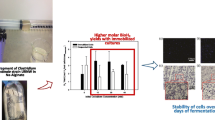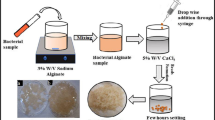Abstract
Benzoate produced from the degradative pathways of various aromatic chemicals is generally recognized as a pollutant compound. However, various bacterial strains isolated as benzoate degraders have exhibited certain limits to their functions, including a loss of viability and degradability when cultivated in a broth medium for a longer time. Accordingly, immobilization techniques have been utilized to overcome such problems, and the current study examined the use of alginate and polyurethane for immobilizingKlebsiella oxytoca C302 to extend its viability and degradability of benzoate. The organism was well encapsulated by both matrices and the immobilized cells showed a high stability as regards their viability and degradability of 2 mM benzoate in a MM2 broth medium during cultivation for longer than 60 h in a semicontinuous batch system.
Similar content being viewed by others

References
Assinder, S. J. and P. A. Williams (1990) The TOL plasmids: Determinants of the catabolism of toluene and the xylenes.Adv. Microbial Physiol. 31: 1–69.
Furukawa, K. (1994) Molecular genetics and evolutionary relationship of PCB-degrading bacteria.Biodegradation 5: 89–300.
Dietrich, D., W. J. Hichey, and R. Lamar (1995) Degradation of 4,4′-dichlorobiphenyl,3,3′,4,4′-tetrachlorobiphenyl, and 2,2′,4,4′,5,5′-hexatetra-chlorobiphenyl by the white rot fungusPhanerochaete chrysosporium.Appl. Environ. Microbiol. 61: 3904–3909.
Brenner, V., J. J. Arensdorf, and D. D. Focht (1994) Genetic construction of PCB degraders.Biodegradation 5: 359–377.
Smith, M. R. and C. Ratledge (1989) Catabolism of biphenyl byPseudomonas sp. NCIB 10643 andNacardia sp. NCIB 10503.Appl. Microbiol Biotechnol. 30: 395–401.
Nam, J. H. and C. K. Kim (1994) Cloning ofpcb genes inPseudomonas sp. P20 specifying degradation of 4-chlorobiphenyl.Kor. J. Appl. Microbiol. Biotechnol. 22: 353–359.
van Agteren, M. H., S. Keuning, and D. B. Janssen (1998)Handbook on Biodegradation and Biological Treatment of Hazardous Organic Compounds. Kluwer Acad. Publ. Netherlands.
Kim, K. P., J. S. Lee, S. I. Park, M. S. Rhee, K. S. Bae, and C. K. Kim (2000) Isolation and identification ofKlebsiella oxytoca C302 and its degradation of aromatic hydrocarbons.Kor. J. Microbiol. 36: 58–63.
Mohamed M. E., A. Zaar, C. Ebenau-Jehle, and G. Fuchs (2001) Reinvestigation of a new type of aerobic benzoate metabolism in the proteobacteriumAzoarcus evansii.J. Bacteriol. 183: 1899–908.
Chae, J. C., K. J. Ahn, and C. K. Kim (1998) Hydrolytic dechlorination of 4-chlorobenzoate specified byfcbABC ofPseudomonas sp. DJ-12.J. Microbiol. Biotechnol. 8: 692–695.
Seo, D. I., J. C. Chae, K. P. Kim, Y. Kim, K. S. Lee, and C. K. Kim (1998) A pathway for 4-chlorobenzoate degradation byPseudomonas sp. S-47.J. Microbiol. Biotechnol. 8: 96–100.
Cassidy, M. B., H. Lee, and J. T. Trevors (1996) Environmental applications of immobilized microbial cells: a review.J. Ind. Microbiol. 16: 79–101.
Mordocco, A., C. Kuek, and R. Jenkins (1999) Continuous degradation of phenol at low concentration using immobilizedPseudomonas putida.Enzyme Microb. Technol. 25: 530–536.
Sahasrabudhe, S. R., A. J. Modi, and V. V. Modi (1998) Dehalogenation of 3-chlorobenzoate by immobilizedPseudomonas sp. B13 cells.Biotechnol. Bioeng. 31: 889–893.
Manohar, S., C. K. Kim, and T. B. Karegoudar (1999) Production of salicylic acid from naphthalene by immobilizedPseudomonas sp. strain NGK1.J. Microbiol. Biotechnol. 9: 482–487.
Mukerjee-Dhar, G., M. Shiura, and K. Kimbara (1998) Degradation of polychlorinated biphenyl by cells ofRhodococcus opacus strain TSP203 immobilized in alginate and in solution.Enzyme Microb. Technol. 23: 34–41.
Manohar, S., C. K. Kim, and T. B. Karegoudar (2001) Enhanced degradation of naphthalene by immobilization ofPseudomonas sp. strain NGK1 in polyurethane foam.Appl. Microbiol. Biotechnol. 55: 311–316.
Arensdorf, J. J. and D. D. Focht (1995) A meta-cleavage pathway for 4-chlorobenzoate an intermediate in the metabolism of 4-chlorobiphenyl byPseudomonas cepacia P166.Appl. Environ. Microbiol. 61: 443–447.
Koo, S. M., Y. H. Cho, C. S. Huh, Y. J. Baek, and J. Y. Park (2001) Improvement of the stability ofLactobacillus casei YIT 9018 by microencapsulation using alginate and chitosan.J. Microbiol. Biotechnol. 11: 376–383.
Quintana, M. G. and H. Dalton (1999) Biotransformation of aromatic compounds by immobilized bacterial strains in barium alginate beads.Enzyme Microb. Technol. 24: 232–236.
Author information
Authors and Affiliations
Corresponding author
Rights and permissions
About this article
Cite this article
Kim, JH., Jeong, WH., Karegoudar, T.B. et al. Stable degradation of benzoate byKlebsiella oxytoca C302 immobilized in alginate and polyurethane. Biotechnol. Bioprocess Eng. 7, 347–351 (2002). https://doi.org/10.1007/BF02933519
Received:
Accepted:
Issue Date:
DOI: https://doi.org/10.1007/BF02933519



